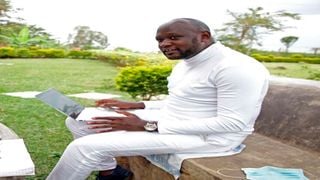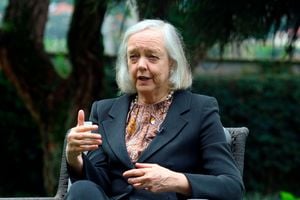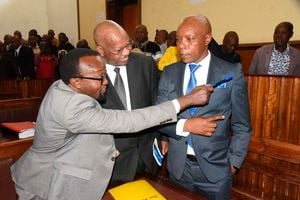
Dr Shem Otoi.
| Tonny Omondi | Nation Media GroupNews
Premium
The face behind Covid-19 modelling that predicts infection waves
What you need to know:
- Predicting the new waves is daunting and takes him literal sleepless nights for him to get an Ahaa moment, which have so far come to pass.
- Asked when the fifth wave is likely to come, he says, he is working on it but the fourth wave will be around until October 4, 2021.
It is quite easy to predict Dr Shem Otoi’s disposition – soft spoken, witty, polymath, spiritual and passionate. Despite his evident qualities being identified in a split-second, the mathematician whose models have correctly predicted Covid-19 waves in the country says the reverse is true when it comes to what he does.
Predicting the new waves is daunting and takes him literal sleepless nights for him to get an Ahaa moment, which have so far come to pass.
If a way-back machine could have been practical in the world we live in, had you asked the 39 year-old if he wanted to pursue Mathematics as an undergraduate course –he would have dissented.
“I wanted to be a medical doctor, mechanical engineer and if the least of my odds fell in place, a law degree would’ve been my last resort,” he tells Nation.
He was an A student and his wit earned him that A grade in the Kenya Certificate of Secondary Education. Despite proving to the then Joint Admissions Board that sciences were his darling, he was called to study a Bachelor of Education, Arts degree in Maseno University in April 2003.
“I was utterly disappointed,” he says.
However, through a mentor, he managed to transfer to Jomo Kenyatta University of Agriculture and Technology (JKUAT) where he was admitted to study Bachelor of Science in Mathematics. His attempt to change to a course of his liking only came two years after applying for course transfer, which was too late.
Any challenge that faces humanity, like Covid-19, makes Dr Otoi tick and his passion burns until he finds a solution.
He tells Nation that he got his ilk from his late grandmother whom he lived with at Mfangano Island in the eastern part of Lake Victoria – one that was a philanthropist by nature and always ready to give service to people.
“My grandmother used to have huge tracts of land where she planted oranges, bananas and tangerine and all of it, she gave them out to people,” she says.
“I look at everything I do from a service point of view, even in the models that I have come up with, I want to save as many people by predicting and coming up with interventions beforehand,” he says.
How modelling started
When Covid-19 came, he did not want to sit back and watch things go on as everyone else did.
“There was a lot of misinformation, as still is, in the earlier days of the pandemic. I remember people making assumptions that Covid-19 could not infect Africans,” he says.
“When the first Covid-19 case was announced in the country, I started scratching my head, comparing Covid-19 infection rate, death rates, and recoveries to other regions of the world,” he explains.
He published his findings at the International Journal of Statistics and Applied Mathematics after it went through a thorough peer-review.
It is then that he started his modeling escapades. He tried two models that did not bear fruit at first. In his third attempt, he used a combination of two –the stochastic model and the aspects of deterministic model.
“I spend almost 16 hours working on the predictions, for two weeks each. I sleep really late, mostly at 3a.m or 4a.m and I wake up by 8 in the morning. I love staying up late because the universal thinking space is not crowded,” he says.
He shared his first findings with friends who were impressed that they asked him to patent his mathematical formulas.
He went ahead to the patenting authorities who told him that there is no provision for that in the country. He opted to pilot it and reached out to Prof (Dr) Richard Muga, former Director of Medical Services in Homa Bay County.
Prof Muga welcomed his idea and gave him a platform to predict data for Homa Bay County. He correctly predicted a surge in October last year when students partially reported back to school.
Prof Muga fronted his idea to the Lake Region Economic Bloc that has 14 counties where Dr Otoi now coordinates programs for the eminent committee in charge of Covid-19 which he describes as a ‘Wonderful group.’
“The greatest award, apart from getting funding for my PhD from the National Research Fund, is being given an opportunity by the LREB Committee of Eminent Persons to serve humanity,” he tells Nation.
While at the LREB, he correctly made predictions of the third wave that happened between February and July when the delta variant was dominant in those counties.
Near-death experience
Before then, he had made predictions of the first and second waves which came to pass.
In between, he contracted Covid-19 and he says that he had a near-death experience.
“I remember being driven to hospital when I was unable to breathe. When I got there, I was asked to pay Sh 200, 000 upfront. I only had Sh50, 000 and two logbooks which were denied. I was only admitted after paying the Sh200, 000 beforehand,” he says.
“Covid-19 is so bad that you cannot wish it even on the devil. When in the intensive care unit, I lost count of the time of the day. A patient died next to me and we later learnt that all along he was on life support. On that night, I think I was dead, or asleep but I remember seeing my late grandmother in a very clean room. When I woke up, I felt better and I gained strength since,” he narrates.
In his hospital days, he could hallucinate that his mother, father and another relative were talking to him and he responded to them at the same time. When he walked out of the hospital healthy," he says, “At the entrance of the hospital, I knelt down and prayed to thank God for the second chance of life.”
“I was convinced that my purpose in this life is to serve humanity,” he adds.
In two days, he was back to his 16-hour long modeling days. He got an insight of when the fourth wave would happen using the models.
Asked when the fifth wave is likely to come, he says, he is working on it but the fourth wave will be around until October 4, 2021.
His modeling helped the LREB that had been ravaged by the Delta variant to reduce cases thanks to a report he did after his prediction that issued advisories.
He calls it the 7th landmark advisory that had about six challenges that needed to be addressed. They include: ramping up oxygen capacity, testing capacity, adequate staffing of health care workers, dealing with cross border infections, vaccination and coming up with an integrated online data system.
He says working on the challenges in the LREB counties helped reduce infections.
“It will take me about two weeks to predict the next wave,” he says
“Right now though, our modeling has observed that we are no longer having blanket waves but rotational, multiple and regional waves. This means that we could be having a surge in Nairobi, but not in Kisumu,” he explains.
He advises other counties to take up lessons from their ‘landmark’ report and implement.
In the future, he is working with other scientists to look into models on Covid-19 reinfection and breakthrough infections which come about after one has been fully vaccinated.
“I am doing this so as to have an insight on the roadmap toward fully reopening of the economy and when to drop the non-pharmaceutical interventions,” he says.
“If my skill can be used to keep some people alive, that is everything to me. I now have a divine calling to use mathematics to save lives,” Dr Otoi says.
How is Covid-19 modeling done?
Modeling involves knowing how to infuse certain indicators and use the results to predict the future trajectory of what you are predicting, in this case, Covid-19.
In the fight against Covid-19, we use resurgence indicators like positivity rate, hospitalisation rate, reproduction rate, daily infections, death rates and recoveries.
Why is modeling important in the fight against Covid-19?
Modeling helps to forecast and predict infections well before they occur.
It supports planning, budgeting, surveillance and response to ensure quick socio-economic recovery and resilience.





